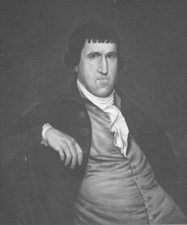Benjamin Goodhue
Benjamin Goodhue | |
|---|---|
 | |
| United States Senator from Massachusetts | |
| In office June 11, 1796 – November 8, 1800 | |
| Preceded by | George Cabot |
| Succeeded by | Jonathan Mason |
| Member of the U.S. House of Representatives from Massachusetts's 10th district | |
| In office March 4, 1795 – June 11, 1796 | |
| Preceded by | District created |
| Succeeded by | Samuel Sewall |
| Member of the U.S. House of Representatives from Massachusetts's 1st district | |
| In office March 4, 1793 – March 3, 1795 | |
| Preceded by | Fisher Ames |
| Succeeded by | Theodore Sedgwick |
| Member of the U.S. House of Representatives from Massachusetts's 2nd district | |
| In office March 4, 1789 – March 3, 1793 | |
| Preceded by | None |
| Succeeded by | Dwight Foster Theodore Sedgwick Artemas Ward William Lyman (General ticket) |
| Personal details | |
| Born | September 20, 1748 Salem, Massachusetts |
| Died | July 28, 1814 (aged 65) Salem, Massachusetts |
| Political party | Federalist |
| Alma mater | Harvard University |
| Occupation | Merchant |
Benjamin Goodhue (September 20, 1748 – July 28, 1814) was a Representative and a Senator from Massachusetts.
Goodhue was born in Salem, Massachusetts and graduated from Harvard College in 1766. He worked as a merchant and became a member of the State house of representatives 1780-1782 and later a State senator in 1783 and 1786-1788. He was also a member of the State constitutional convention in 1779 and 1780. Goodhue was elected to the First and to the three succeeding Congresses and served from March 4, 1789, until his resignation in June 1796.[citation needed]
He was chairman of the Committee on Commerce and Manufactures in the Fourth United States Congress. He was elected in 1796 as a Federalist to the United States Senate to fill the vacancy caused by the resignation of George Cabot. He was reelected and served from June 11, 1796, to November 8, 1800, when he resigned. He died in Salem on July 28, 1814.[citation needed]
Legacy
He is buried in Broad Street Cemetery. A World War II Liberty ship was named in his honor. Goodhue was a member of the Federalist Party and its Essex Junto.[citation needed]
External links
- United States Congress. "Benjamin Goodhue (id: G000286)". Biographical Directory of the United States Congress.
- 1748 births
- 1814 deaths
- Harvard University alumni
- Massachusetts State Senators
- Members of the Massachusetts House of Representatives
- Members of the United States House of Representatives from Massachusetts
- United States Senators from Massachusetts
- Massachusetts Federalists
- Federalist Party United States Senators
- Burials in Massachusetts
- Federalist Party members of the United States House of Representatives
- Politicians from Salem, Massachusetts
- Burials at Broad Street Cemetery
- People of colonial Massachusetts
- Massachusetts United States Representative stubs
- Massachusetts state senator stubs




